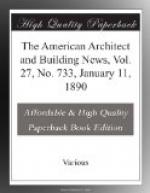The city gate played then, as it still does all through the East, an important role in the life of the urban populations. It was an agora for the Greeks, a forum for the Romans. The people gathered there to chat, and learn the news, and there the old men acted as arbitrators in case of quarrels. In the same way it was at the palace-gates, which were always constructed on the model of the city-gates, that the court attendants assembled, and that petitioners stood in waiting.
The Phoenician cities also were surrounded by fortified walls, and dwellings were burrowed into the very body of the ramparts. In order not to extend the limits of the city too much, the houses in the central portions were built very high. In the chief quarters of Carthage some of them had as many as six stories; they were covered with flat roofs, and, as is the case of all warm countries, the streets were narrow. The residences of the rich merchants were of a marked character and were easily distinguished; they were all provided with cisterns; they had inner courts adorned with porches, and with open galleries along the upper stories. The streets, squares and courts were paved with broad flags, probably for the purpose of saving every drop of water that fell. There were also public cisterns, and ports for shipping. As their country abounded in stone that could be easily cut, the Phoenicians used no artificial building material: they are not known to have built of brick before the Roman period.
In Judea, while enormous, rough blocks were used in huge structures, the houses were made of unburned brick, with ceilings of palm or sycamore beams covered with a layer of hard earth. In order that the variations in temperature should not be felt in the interior, the outer walls and the roof had to be quite thick. All the dwellings were covered with flat roofs surrounded by a parapet, and here people passed the night in certain seasons. Most houses had only a ground-floor; but the residences of the wealthy sometimes boasted of an upper story, and certain windows, doubtless those lighting the women’s apartments, were provided with lattices similar to the moucharabiehs of the Arab houses of the present day.
The villages were generally built on the hill-tops, and the more important of them were surrounded with fortifications. Jerusalem was the seat of royalty. It was there that David reared his palace, to which Solomon added numerous edifices that occupied thirteen years in construction. Other great works were undertaken by the Hebrews, with the view of carrying to a distance the precious water of the springs; and they were compelled to supplement their scant supply of water by digging wells and making cisterns.
In Egypt, the attention of archaeologists was so long riveted on the temples and tombs that it is only recently that a study has been made of private dwellings. To-day, however, something is known of these.




